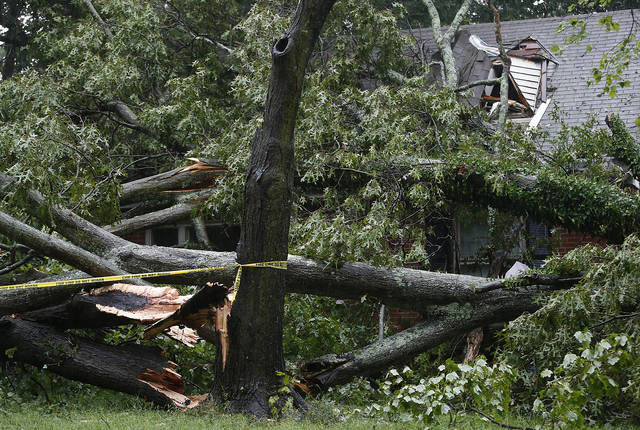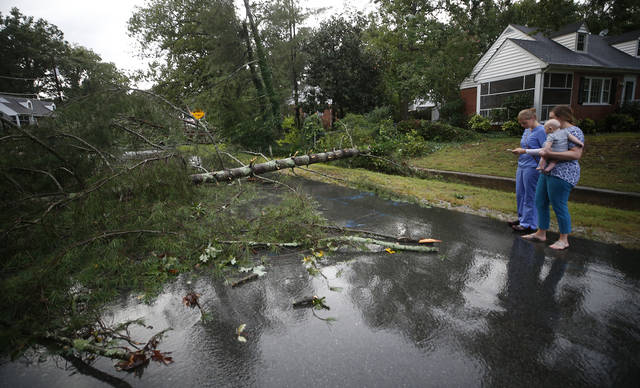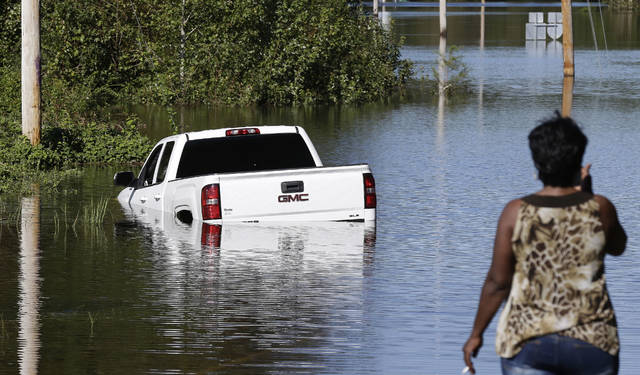WILMINGTON, N.C. — Still stranded by Florence’s epic floods days after the hurricane hit North Carolina, Wilmington residents lined up by the hundreds Tuesday for free food, water and tarps as officials struggled to open new routes to one of the state’s largest cities.
The death toll from the storm rose to at least 32 in three states, with 25 fatalities in North Carolina, as remnants of the once-powerful Category 4 hurricane — now reduced to a rainy, windy mass of low pressure — dumped rain on the heavily populated Northeast.
In Wilmington, population 120,000, workers began handing out supplies using a system that resembled a fast-food restaurant drive-thru: Drivers pulled up to pallets lining a street, placed an order and left without having to get out.
Todd Tremain needed tarps to cover up spots where Florence’s winds ripped shingles off his roof. “The roof is leaking, messing up the inside of the house,” he said.
Others got a case of bottled water or military MREs, or field rations. An olive-green military forklift moved around huge pallets loaded with supplies.
Four days after Florence blew ashore and began unloading more than 2 feet of rain that paralyzed much of North Carolina, Wilmington was still virtually cut off from the rest of the state, with just one road tentatively open as a supply route. Officials said they will open roads as flooding recedes and downed trees and power lines are cleared away. It’s not clear when that might happen.
Items have been brought into the city by big military trucks and helicopters, which also have been used to pluck hundreds of desperate people from atop homes and other structures.
“Thank you,” a shirtless Willie Schubert mouthed to members of a Coast Guard helicopter crew who picked up him and his dog Lucky from atop a house encircled by water in Pollocksville on Monday. It wasn’t clear how long he had been stranded.
The dead include a 1-year-old boy who was swept away after his mother drove into floodwaters and lost her grip on him. Authorities in Virginia said one person was dead after an apparent tornado.
The rain finally stopped and the sun peeked through on Monday, but North Carolina Gov. Roy Cooper warned that dangerously high water would persist for days. He urged residents who were evacuated from the hardest-hit areas to stay away because of closed roads and floodwaters that submerged entire communities.
“There’s too much going on,” he said.
Utility crews from multiple states worked to restore power, and outages were down from a high of more than 900,000 to about 320,000 homes and businesses, nearly all in North Carolina.
Crews conducted about 700 rescues in New Hanover County, where Wilmington is located. About half of all homes and businesses were without power Tuesday, a big improvement from a day earlier. Roads were being cleared and the landfill was open to accept storm refuse.
Mayor Bill Saffo said he was working with the governor’s office to get more fuel into Wilmington.
“At this time, things are moving as well as can be in the city,” he said.
Downgraded from a tropical depression, the deadly storm still had abundant rain and top winds around 25 mph (40 kph). Forecasters said states in the Northeast are in for as much as 4 inches (10 centimeters) of rain before the system moves offshore again.
———
Waggoner reported from Raleigh, North Carolina. Associated Press photographer Steve Helber in Pollocksville, North Carolina, and AP writers Jonathan Drew in Lumberton, North Carolina; Gary Robertson in Raleigh; and Jay Reeves in Atlanta contributed to this report.
———
Follow Martha Waggoner on Twitter at http://twitter.com/mjwaggonernc
———
For the latest on Hurricane Florence, visit https://www.apnews.com/tag/Hurricanes





